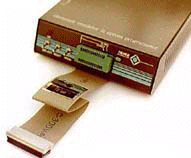


DENEB Z80 seriale full stand-alone emulator is the essential aid for the
development and production of Z80 microprocessor-based systems. Using a serial
interface it can be easily connected with terminals, personal computer and more
powerful hosts, moreover the incorporated eprom programmer allow to program most
diffuse existing eproms.
Introduction
With this instrument it is possible to execute a program in machine language
step-by-step and verify every time the content of registries and memory,
so that you are able to understand possible malfunctions of the software that is
being tested. To work without an emulator on a microprocessor card is equally
possible, but it is necessary to assemble the program, to write an
EPROM, to insert it in the card and to reset the system. At this point we
will have only two possibility: or the program works perfectly, much improbable
especially if it is enough long, or it jump somewhere or stop for an unknown
error. With the aid of this machine, it is possible to find the errors in few
time simply executing step-by-step the program and verifying the registries or
setting breakpoints in determined zones of program and then starting the
execution in real time. From this short description of how to use the emulator,
you can understand that it is not only an aid, but it is indispensable to
projects' developers.
Hardware
details of DENEB Z80 Educational emulator:
 It is realized in a single card and a single µp Z80 that is used for
monitor, eprom-programmer and emulator. It is realized in a single card and a single µp Z80 that is used for
monitor, eprom-programmer and emulator. - Emulator's memory is divided in 2 banks of 32KB. Higher bank (from 8000h
to FFFFh) is reserved for the emulator, the other (from 0000h to 7FFFh) is
available for user and is subdivided as follow:
- First 8K of memory (0000h÷1FFFh) can be or INTERNAL or EXTERNAL to the
emulator, using command " Set/Show map of memory "; here it is possible to test a program with several breakpoints and
the command of the menů run. (N.B.: excluded the 3 address 66h-67h-68h (jump
of the program at the pressure of NMI) where is not possible to set
brekpoint or to debug at step by step; it is clearly that the NMI
can be received);
- Remaining 24K are for the external target of the customer (2000h÷7FFFh);
- There are others 7K of ram available for user from A000h to BC00h in the
internal memory of the emulator where is it possible to write and emulate a
program;
- Higher 32K of memory in MREQ from 8000h to FFFFh must do not be in conflict with
internal ones: the machine is composed by a
single microprocessore that manages the monitor and the
emulation, therefore an eventual external wrong HW can block the operation
of the emulator! Make sure that the hardware for the
external memory, in the target of the customer, it is always conditioned by the
/MREQ and that A15 = 0, in order to avoid the conflict of Bus with the
monitor of the emulator, that uses the A15=1.
- The emulation is completely symbolic: can be used up to 4096 symbols with maximum
lenght of 14 characters.
- The source of clock can be internal or external and is selectable through the
switch on front panel called PROG (the programming of the
clock).
- It works on the serial port of a IBM-PC, compatible AT in full stand-alone
mode with 28800 baud-rate and software protocol XON/XOFF .
 From today it is possible to use also USB
interface through the cable-converter and the new Microhandler software;
compatible with Windows 2000-XP-Win7-Win10. From today it is possible to use also USB
interface through the cable-converter and the new Microhandler software;
compatible with Windows 2000-XP-Win7-Win10.
Contact us for information, availability and prices.
- The consumption at 5Volt is of approximately 600mA, the power is supplied
from a adapter of 9-12Vdc 800mA, that is stabilized internally.
Firmware
DENEB Z80 Educational
Exclusively for this emulator it has been created by DENEB the
hardware/software communication interface HANDLER MICRO.
For Windows version, compatible with USB interface, please refer to
Microhadler for Window page.
DOS Version:
It start
launching Z80.EXE.
It use a menu bar situated in the first line, from which you
can have access to global menu (Rows, Run, Memory, etc.) . Global menu are characterize from a name and one evidenced letter. A
global
menů can be opened by pressing the keys < ALT > + evidenced letter of the
menů, so you have access to all the commandos visualizes to you in the opened
menu. In order to execute a command it
can be proceeded in three ways:
- Striking the evidenced letter of the command.
- Moving the cursor on the command wished with the direction keys,
then press < RETURN > or < SPACEBAR > .
- Directly pressing the keys function or the combination of keys
, that appear on the right of the command (that can be executed also
without to open the menů, to speed-up all the job).
The interface accept all numerical data (addresses , registers,
memory data, etc. ) in decimal, exadecimal, octal and binary
format. The emulator manages the
symbols in the IAR-SYMBOLIC format. Symbols can be digitated even with capital
or small letter. A symbol digited with capital
letters is considered different from that one with small letters .
|

 It is realized in a single card and a single µp Z80 that is used for
monitor, eprom-programmer and emulator.
It is realized in a single card and a single µp Z80 that is used for
monitor, eprom-programmer and emulator.